Como Italy / Italia
- Maria Scuor
- Sep 20, 2024
- 16 min read
Italiano sotto ogni sezione
We’ve been to Como before when it was pouring rain and very cold, which left me a bad first experience. Therefore, I had to give it another chance and see what all the hype is about or is it just the George Clooney effect…..
My cousin Mimma was visiting us, as she does every year, and this particular day was her birthday and we decided to take her on an adventure. She didn’t know where we were taking her but didn’t take long on the travelled road to see the Como signs. She was happy and that made us happy!
Como is a city and municipality in the Lombardy region of the Province of Como. The province has a population of about 491,000 and Como at the southern tip of Lake Como there are about 84,000 inhabitants. Being on Lake Como and surrounded by the Alps has made this a very popular tourist destination. There are many places to see and 1 day isn’t enough to see them all but we did get to see what we had on our list which made it for a great day.
I say this in everyone of my Italy blogs because it is so TRUE….Like all cities or towns in Italy, Como was inhabited and ruled by many races of people. Dating back 10,000 to the Iron Age it was the Celtics, Ancient Ligurians, and Gaulish that lived here. It came under Roman in 49 BC by Julius Caesar. He moved the town that was situated on the hills to its current location near the lake and called the new town Novum Comum, with a status of municipium.
Como was thriving under the Romans but then the Goths and Huns who imposed high taxes and life declined. In 774 AD, the Longobards freed the city and it flourished again. Como became a commune in the 11th century and during this period of growth, the communes of Como and Milan became rivals which lead to the Decennial War between Como and Milan, which Como lost and Milan destroyed every building in Como except for the churches in 1127. Como was forced to pay tribute to Milan, but this changed when Frederick Barbarossa destroyed Milan in 1162.
Then came the French, Spanish and Austrian rule which saw periods of decline due to hefty taxes. It was 1859 that Lake Como became part of Italy under the House of Savoy after Giuseppe Garibaldi defeated the Austrians at the battle of San Fermo. For much of the 18th and 19th centuries it enjoyed a period of peace and prosperity as the area’s silk manufacturing became world-renowned because the Visconti family cultivated mulberry trees for breeding silkworms. Como is still considered the world leader in production of high-quality silk.
Here is a TikTok video and photos of the sights we saw in Como - Ecco un video TikTok e le foto dei luoghi che abbiamo visto a Como
Como
Siamo già stati a Como quando pioveva a dirotto e faceva molto freddo, il che mi ha lasciato una brutta prima esperienza. Pertanto, ho dovuto dargli un'altra possibilità e vedere di cosa si trattasse o è solo l'effetto George Clooney.....
Mia cugina Mimma veniva a trovarci, come fa ogni anno, e quel giorno in particolare era il suo compleanno e abbiamo deciso di portarla all'avventura. Non sapeva dove la stavamo portando, ma non ci ha messo molto sulla strada percorsa per vedere i cartelli di Como. Era felice e questo ci ha reso felici!
Como è un comune della provincia di Como, in Lombardia. La provincia ha una popolazione di circa 491.000 abitanti e Como, all'estremità meridionale del Lago di Como, conta circa 84.000 abitanti. Essendo sul Lago di Como e circondata dalle Alpi ha reso questa una meta turistica molto popolare. Ci sono molti posti da vedere e 1 giorno non è sufficiente per vederli tutti, ma siamo riusciti a vedere quello che avevamo nella nostra lista, il che lo ha reso una giornata fantastica.
Lo dico in tutti i miei blog in Italia perché è così VERO....Come tutte le città o paesi in Italia, Como era abitata e governata da molte razze di persone. Risalenti al 10.000 e all'età del ferro, qui vivevano i Celti, gli Antichi Liguri e i Galli. Passò sotto il controllo romano nel 49 a.C. ad opera di Giulio Cesare. Trasferì la città che si trovava sulle colline nella sua attuale posizione vicino al lago e chiamò la nuova città Novum Comum, con lo status di municipium.
Como era fiorente sotto i Romani, ma poi i Goti e gli Unni che imposero tasse elevate e la vita declinò. Nel 774 d.C., i Longobardi liberarono la città che ricantò. Como divenne comune nell'XI secolo e durante questo periodo di crescita, i comuni di Como e Milano divennero rivali che portarono alla guerra decennale tra Como e Milano, che comò perse e Milano distrusse tutti gli edifici di Como tranne le chiese nel 1127. Como fu costretta a rendere omaggio a Milano, ma le cose cambiarono quando Federico Barbarossa distrusse Milano nel 1162.
Poi arrivarono le dominazioni francesi, spagnole e austriache che videro periodi di declino a causa delle pesanti tasse. Era il 1859 quando il Lago di Como entrò a far parte dell'Italia sotto Casa Savoia dopo che Giuseppe Garibaldi sconfisse gli austriaci nella battaglia di San Fermo. Per gran parte del XVIII e XIX secolo ha goduto di un periodo di pace e prosperità poiché la lavorazione della seta della zona divenne famosa in tutto il mondo perché la famiglia Visconti coltivava gelsi per l'allevamento dei bachi da seta. Como è ancora oggi considerata il leader mondiale nella produzione di seta di alta qualità.
Brunate
We made our way through town to get to the Brunate funicular (cable railway system on steep slope). Having researched it, I was surprised to see there wasn’t that long of a lineup to go take the ride up the mountain from Como-Brunate. The price was 6.60 euros for a round-trip length of 1,084 metres (3,556 ft) and a 496 (1,627) metres rise. Thankfully the weather was great and were able to see the view as we travelled up the mountain.
This railway has operated since 1894 and is used by residents and tourists. Originally it was using steam engine, but in 1911 it was converted to electric motor. In 2011, the funicular went through a major overhaul of both the system and the cars. The cars are air conditioned and one is painted lilac and the other red. Each car can transport up to 81 passengers. The travel time each direction is seven minutes with a frequency of every 15 or 30 minutes.
Once we got up to the top of Brunate the first thing we saw was the coffee bar and souvenir shop. Amazing thing was it was called Serafino which was my daddy’s name and a name not usually seen in northern Italy. So of course, we had to have coffee and buy some souvenirs.
Brunate is an Italian town at 715 metres above sea level, in the province of Como and has 1,593 inhabitants. Artifacts that were dug up in February 1909 suggests there was a Celtic tribe in the area around 6th century BC. It too followed Como’s path with many rulers but in by 1240 it was once again under the jurisdiction of Como.
A turning point for Brunate was the foundation of the monastery of San’t Andrea in 1340. It was configured as a place of religious isolation because it was very hard to access it. A mule track that was built in 1817 with a staircase of 1630 steps connected the village with Como and that helped with accessibility.
Between the 19th and 20th century, Brunate became a famous destination for the wealthy Milanese families, who built their incredible villas. Tourists started to come once the funicular opened in 1894 and the influx continued until the Second World War, when the town, protected from possible bombings by its proximity to Switzerland, became a destination for many displaced people. However, in 1943, Brunate lost its autonomy and became a hamlet of Como and returned to being a municipality in 1947.
After the Second World War, Brunate’s casino closed, the prestigious hotels ceased operations and the town went from “elite” holiday resort to a “just visit for the day” tourist destination. The typical visitor is there to see the centre, the Volta Lighthouse and the views. Just like we did when we were there.
We didn’t get to see the Volta Lighthouse as the shuttle service was not in service. If it wasn’t so hot we could have walked 30 minutes up the 1.2 km road hill with 186 metre elevation gain to the summit of Monte Tre Croci (San Maurizio). The 29-metre octagonal lighthouse opened on September 8th, 1927, to commemorate the 100th anniversary of Alessandro Volta’s (developed the first electrical cell) death. Inside, it has a spiral staircase with 143 steps that brings you to two circular balconies. You can pay 2-euro admission and climb to the top of the lighthouse for wonderful views over the Alps and the surrounding lowland.
We visited the Church of Sant'Andrea Apostolo which is dedicated to St. Andrew the Apostle and is located just a few minutes walk from funicular. It has been a parish church since 1654. The first news of it dates back to the 14th century with the monastery which has since been demolished.
Rebuilt in the 19th century and enlarged between 1914 and 1927 (hence the two facades). On the facade of the church are engraved the Latin words FAMVLVS DEI DIGNUS APOSTULUS PETRI GERMANUS ET IN PASSIONE, or in Italian: [Andrea:] servant of God, worthy apostle, brother of Peter also in martyrdom.
Inside the church, in a niche along the right side, there is an altar dedicated to the blessed Maddalena Albrici (1390 – 1465) which holds her relics underneath it. She was the abbess of the ancient monastery and was beatified on December 11 1907 by Pope Pius X. Of interest is also the pipe organ that was built by the Prestinari brothers of Magenta in 1827. They used materials from a previous Serassi organ from 1774 and was restored in the 20th century. It has two keyboards and 58 keys and a flat pedalboard of 27 notes and was restored, by Ilic Colzani in 2005.
Funicular - Funicolare
Exterior / Esterno Sant'Andrea Apostolo
Interior / Interno Sant'Andrea Apostolo
Brunate
Abbiamo attraversato la città per raggiungere la funicolare di Brunate (sistema di funivie in forte pendenza). Dopo averlo ricercato, sono rimasto sorpreso di vedere che non c'era una fila così lunga per andare a fare il giro su per la montagna da Como-Brunate. Il prezzo era di 6,60 euro per una lunghezza di andata e ritorno di 1.084 metri (3.556 piedi) e un dislivello di 496 (1.627) metri. Per fortuna il tempo era fantastico e siamo stati in grado di vedere il panorama mentre viaggiavamo su per la montagna.
Questa ferrovia è in funzione dal 1894 ed è utilizzata da residenti e turisti. Originariamente utilizzava un motore a vapore, ma nel 1911 fu convertito in motore elettrico. Nel 2011, la funicolare ha subito un'importante revisione sia del sistema che delle vetture. Le auto sono dotate di aria condizionata e una è dipinta di lilla e l'altra di rosso. Ogni vettura può trasportare fino a 81 passeggeri. Il tempo di percorrenza in ogni direzione è di sette minuti con una frequenza di ogni 15 o 30 minuti.
Una volta arrivati in cima a Brunate, la prima cosa che abbiamo visto è stato il bar e il negozio di souvenir. La cosa incredibile era che si chiamava Serafino, che era il nome di mio padre e un nome che di solito non si vede nel nord Italia. Quindi, ovviamente, dovevamo prendere un caffè e comprare qualche souvenir.
Brunate è un comune italiano situato a 715 metri sul livello del mare, in provincia di Como e conta 1.593 abitanti. I manufatti che sono stati scavati nel febbraio 1909 suggeriscono che c'era una tribù celtica nella zona intorno al VI secolo a.C. Anch'essa seguì il percorso di Como con molti dominatori ma nel 1240 era di nuovo sotto la giurisdizione di Como.
Un punto di svolta per Brunate fu la fondazione del monastero di San't Andrea nel 1340. Si configurava come un luogo di isolamento religioso perché era molto difficile accedervi. Una mulattiera che fu costruita nel 1817 con una scalinata di 1630 gradini collegava il paese con Como e che ne facilitava l'accessibilità.
Tra il XIX e il XX secolo, Brunate divenne una meta famosa per le ricche famiglie milanesi, che costruirono le loro incredibili ville. I turisti iniziarono ad arrivare una volta aperta la funicolare nel 1894 e l'afflusso continuò fino alla seconda guerra mondiale, quando la città, protetta da possibili bombardamenti dalla sua vicinanza alla Svizzera, divenne meta di molti sfollati. Tuttavia, nel 1943, Brunate perse la sua autonomia e divenne frazione di Como e tornò ad essere comune nel 1947.
Dopo la seconda guerra mondiale, il casinò di Brunate chiuse, i prestigiosi alberghi cessarono l'attività e la città passò da luogo di villeggiatura "d'élite" a meta turistica "solo da visitare per un giorno". Il visitatore tipico è lì per vedere il centro, il faro del Volta e il panorama. Proprio come abbiamo fatto noi quando eravamo lì.
Non siamo riusciti a vedere il faro di Volta perché il servizio navetta non era in servizio. Se non fosse stato così caldo avremmo potuto camminare per 30 minuti su per la collina stradale di 1,2 km con 186 metri di dislivello fino alla cima del Monte Tre Croci (San Maurizio). Il faro ottagonale di 29 metri fu inaugurato l'8 settembre 1927 per commemorare il 100° anniversario della morte di Alessandro Volta (che sviluppò la prima cella elettrica). All'interno, ha una scala a chiocciola con 143 gradini che porta a due balconi circolari. L'ingresso costa 2-euro e sale in cima al faro per godere di una splendida vista sulle Alpi e sulla pianura circostante.
Abbiamo visitato la Chiesa di Sant'Andrea Apostolo che è dedicata a Sant'Andrea Apostolo e si trova a pochi minuti a piedi dalla funicolare. Dal 1654 è chiesa parrocchiale. Le prime notizie risalgono al XIV secolo con il monastero che da allora è stato demolito.
Ricostruita nel XIX secolo e ampliata tra il 1914 e il 1927 (da qui le due facciate). Sulla facciata della chiesa sono incise le parole latine FAMVLVS DEI DIGNUS APOSTULUS PETRI GERMANUS ET IN PASSIONE, ovvero in italiano: [Andrea:] servo di Dio, degno apostolo, fratello di Pietro anche in martirio.
All'interno della chiesa, in una nicchia lungo il lato destro, si trova un altare dedicato alla beata Maddalena Albrici (1390 – 1465) che custodisce le sue reliquie al di sotto di esso. Era badessa dell'antico monastero e fu beatificata l'11 dicembre 1907 da papa Pio X. Interessante è anche l'organo a canne che fu costruito dai fratelli Prestinari di Magenta nel 1827. Hanno utilizzato materiali provenienti da un precedente organo Serassi del 1774 ed è stato restaurato nel XX secolo. Ha due tastiere e 58 tasti e una pedaliera piatta di 27 note ed è stato restaurato da Ilic Colzani nel 2005.
San Fedele Basilica - Basilica di San Fedele
The Basilica is located in the centre of town in Piazza San Fedele which used to be used to be a forum and until the 19th century had a grain market. The church is built on a previous religious site and dates back to 1120. The façade is in neo-Romanesque style and rebuilt from scratch by Antonio Giussani in 1914. Just above the central nave is a rose window from the 16th century that was recovered from the previous façade.
The bell tower on the left side of the façade replaced a previous one that collapsed during the earthquake in 1117. It has parts from different historical periods. The lower part dates back to 1271 but the upper part had to be demolished and rebuilt due to instability in 1905. It has a square plan with two orders of windows on each side, double lancet windows on the bottom and triple lancet windows above. Inside the bell chamber there are three bells in the concert of G major.
The interior has a Latin cross plan and is divided in three naves with four bays each. The main nave is in Baroque style and is covered with a barrel vault and lunettes. The transept is formed by two asps, the right one contains a marble altar with a papier-mâché Crucifix. The left transept is dedicated to the Madonna and also has a marble altar.
There are many frescos and statues throughout the basilica. The ambulatory is covered with a frescoed octagonal dome and at the centre of the presbytery, delimited by a marble balustrade, is the high baroque altar, which are the preserved remains of San Fedele.
The pipe organ is a Mascioni opus 560 pipe organ built in 1941 and resorted in 2000. It has an electronic transmission and its console is located in the main apse. It has three keyboards with 61 notes on each and a concave-radial pedalboard with 32 notes.
Here is a TikTok video and photos of San Fedele Basilica - Ecco un video TikTok e le foto della Basilica di San Fedele
Exterior - Esterno
Interior - Interno
Basilica di San Fedele
La Basilica si trova nel centro della città, in Piazza San Fedele, che un tempo era un foro e fino al XIX secolo ospitava un mercato del grano. La chiesa è costruita su un precedente sito religioso e risale al 1120. La facciata è in stile neoromanico e ricostruita ex novo da Antonio Giussani nel 1914. Appena sopra la navata centrale si trova un rosone del XVI secolo recuperato dalla facciata precedente.
Il campanile sul lato sinistro della facciata sostituì un precedente che crollò durante il terremoto del 1117. Ha parti di diversi periodi storici. La parte inferiore risale al 1271 ma la parte superiore dovette essere demolita e ricostruita a causa dell'instabilità nel 1905. Ha una pianta quadrata con due ordini di finestre per lato, bifore in basso e trifore in alto. All'interno della camera campanaria sono presenti tre campane nel concerto di sol maggiore.
L'interno è a croce latina ed è diviso in tre navate con quattro campate ciascuna. La navata principale è in stile barocco ed è coperta da una volta a botte e lunette. Il transetto è formato da due aspidi, quello destro contiene un altare marmoreo con un Crocifisso in cartapesta. Il transetto sinistro è dedicato alla Madonna e presenta anche un altare marmoreo.
Ci sono molti affreschi e statue in tutta la basilica. Il deambulatorio è coperto da una cupola ottagonale affrescata e al centro del presbiterio, delimitato da una balaustra marmorea, si trova l'altare maggiore barocco, di cui sono conservate le spoglie di San Fedele.
L'organo a canne è un organo a canne Mascioni opus 560 costruito nel 1941 e utilizzato nel 2000. Ha una trasmissione elettronica e la sua console si trova nell'abside principale. Ha tre tastiere con 61 note su ciascuna e una pedaliera concava-radiale con 32 note.
Como Cathedral – Duomo di Como
The cathedral is dedicated to the assumption of the Blessed Virgin Mary and is the main place of worship in the city of Como. Situated near the lake, it is one of the most notable monuments in Northern Italy. The construction began in 1396 because the previous church of Santa Maria Maggiore was too small and was being flooded by the lake.
With many challenges, death of architects and builders, and roadblocks, the church was constructed over several centuries. Changing from Gothic style of the façade with spires and pinnacles to Renaissance style of the external sides and the apse. The west side with its rose window was built between 1457 and 1498. The dome was designed by Filippo Juvarra but he died before the completion of his Rococo cupola was completed in 1770.
It is an impressive 87 metres long, 36 – 56 metres wide and 75 metres high at the top of the dome. It has a Latin Cross plan with three naves and a transept surmounted by an imposing dome. This cathedral dominates the Piazza del Duomo with is grandeur.
The pipe organ was built in 1932 with three keyboards and pedals. In 1981 the organ was further expanded with an installation of new console with four keyboards and pedals. It was restored and expanded by the Mascioni company in 2000 with the addition of 122 more pipes and two registers. It is electronically operated with 69 registers, for a total of 6515 pipes on four manuals and pedals.
The Como Cathedral doesn’t have its own bell tower. The four bells of the cathedral are installed in the civic tower. The upper part was built in 1927 and it had been demolished in 1910 due to risk of collapse. The bells of the cathedral form a concert in D♭. There is also a civic bell of note Re³, forged in Como by Guillaume de Clermont, master founder from Auvergne, in 1448, which weighs well 1,914 kg. This bells rings at midday on weekdays and is the largest historical bell in Lombardy still in operation.
Both the exterior and interior of this cathedral are adorned with amazing sculptures, frescoes, tapestry and so much more. You could spend days looking at everything in detail and one piece would be more amazing then the next. There is no way I could do it justice in writing anything more about this amazing piece of architecture and history. No wonder it took almost four centuries to complete. Truly a MUST-see cathedral.
Here is a TikTok video and photos of the Como Cathedral - Ecco un video TikTok e le foto del Duomo di Como
Exterior - Esterno
Interior - Interio
Duomo di Como
Il Duomo è dedicato all'Assunzione della Beata Vergine Maria ed è il principale luogo di culto della città di Como. Situata nei pressi del lago, è uno dei monumenti più importanti del Nord Italia. La costruzione iniziò nel 1396 perché la precedente chiesa di Santa Maria Maggiore era troppo piccola e veniva allagata dal lago.
Con molte sfide, la morte di architetti e costruttori e blocchi stradali, la chiesa fu costruita nel corso di diversi secoli. Si passa dallo stile gotico della facciata con guglie e pinnacoli allo stile rinascimentale dei lati esterni e dell'abside. Il lato ovest con il rosone fu costruito tra il 1457 e il 1498. La cupola fu progettata da Filippo Juvarra, che però morì prima che il completamento della sua cupola rococò fosse completato nel 1770.
È lungo ben 87 metri, largo 36-56 metri e alto 75 metri in cima alla cupola. Ha una pianta a croce latina con tre navate e un transetto sormontato da un'imponente cupola. Questa cattedrale domina con imponenza Piazza del Duomo.
L'organo a canne è stato costruito nel 1932 con tre tastiere e pedali. Nel 1981 l'organo è stato ulteriormente ampliato con l'installazione di una nuova consolle con quattro tastiere e pedaliere. E' stato restaurato e ampliato dalla ditta Mascioni nel 2000 con l'aggiunta di altre 122 canne e due registri. E' azionato elettronicamente con 69 registri, per un totale di 6515 canne su quattro manuali e pedali.
Il Duomo di Como non ha un proprio campanile. Le quattro campane della cattedrale sono installate nella torre civica. La parte superiore era stata costruita nel 1927 ed era stata demolita nel 1910 a causa del rischio di crollo. Le campane della cattedrale formano un concerto in Re♭. Di nota è anche una campana civica Re³, forgiata a Como da Guillaume de Clermont, maestro fondatore dell'Alvernia, nel 1448, che pesa ben 1.914 kg. Questa campana suona a mezzogiorno nei giorni feriali ed è la più grande campana storica della Lombardia ancora in funzione.
Sia l'esterno che l'interno di questa cattedrale sono adornati con incredibili sculture, affreschi, arazzi e molto altro ancora. Potresti passare giorni a guardare tutto nei dettagli e un pezzo sarebbe più sorprendente dell'altro. Non c'è modo di rendergli giustizia scrivendo qualcosa di più su questo straordinario pezzo di architettura e storia. Non c'è da stupirsi che ci siano voluti quasi quattro secoli per completarlo. Davvero una cattedrale da vedare.
CHERISHED MEMORIES MADE - RICORDI PIACEVOLI CREATI
We had an amazing day exploring Como with Mimma and will truly cherish the time we spent with her. Being that we saw many religious places we felt our angels with us everywhere we went, especially when we saw dads name Serafino written at the beginning and end of our visit. As well as Cristiano, which is my mother’s and Mimma’s maiden name. It truly was a blessed day.
Photos of us enjoying our day - Ecco foto che ci godiamo la giornata
Abbiamo trascorso una fantastica giornata esplorando Como con Mimma e apprezzeremo davvero il tempo che abbiamo trascorso con lei. Dato che abbiamo visto molti luoghi religiosi, abbiamo sentito i nostri angeli con noi ovunque siamo andati, soprattutto quando abbiamo visto il nome di papà Serafino scritto all'inizio e alla fine della nostra visita. Così come Cristiano, che è il nome da nubile di mia madre e di Mimma. È stato davvero un giorno benedetto.


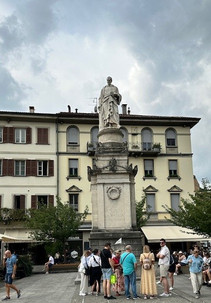
















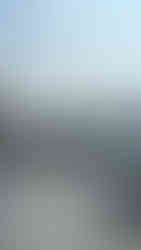












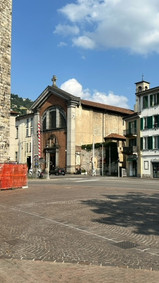





























































































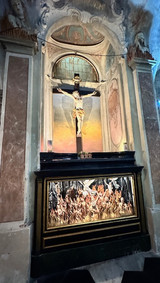













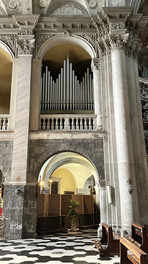














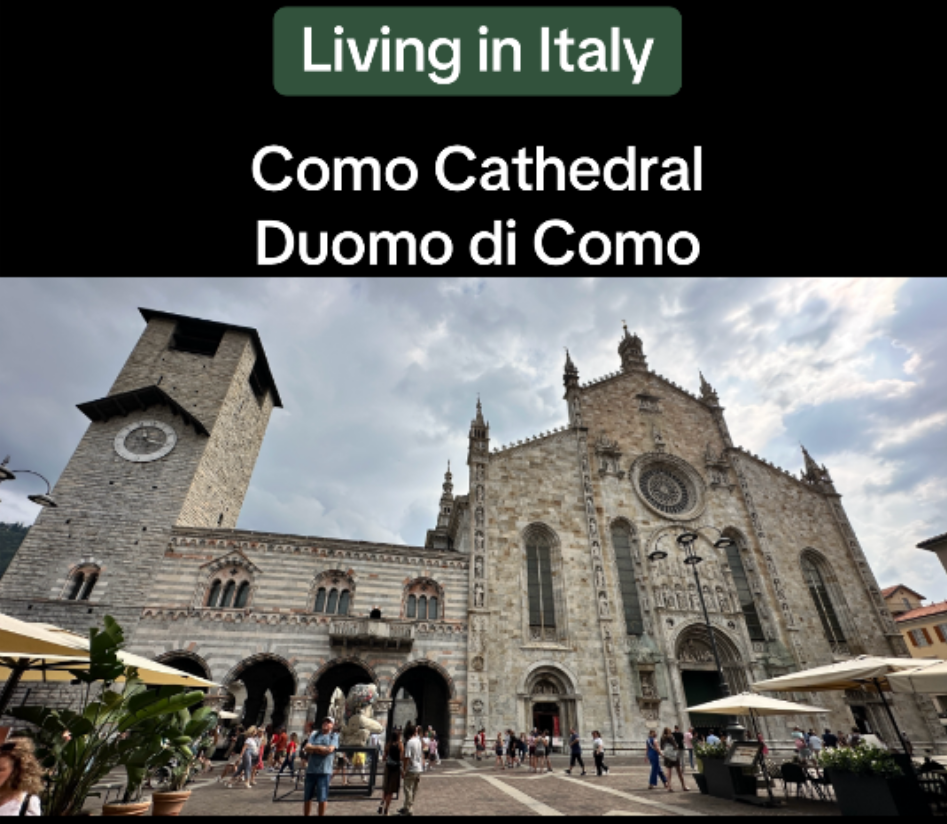







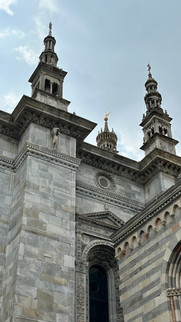













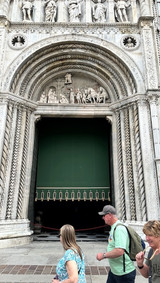









































Comments